
We may earn revenue from product links on this page and participate in affiliate programs. Learn More ›

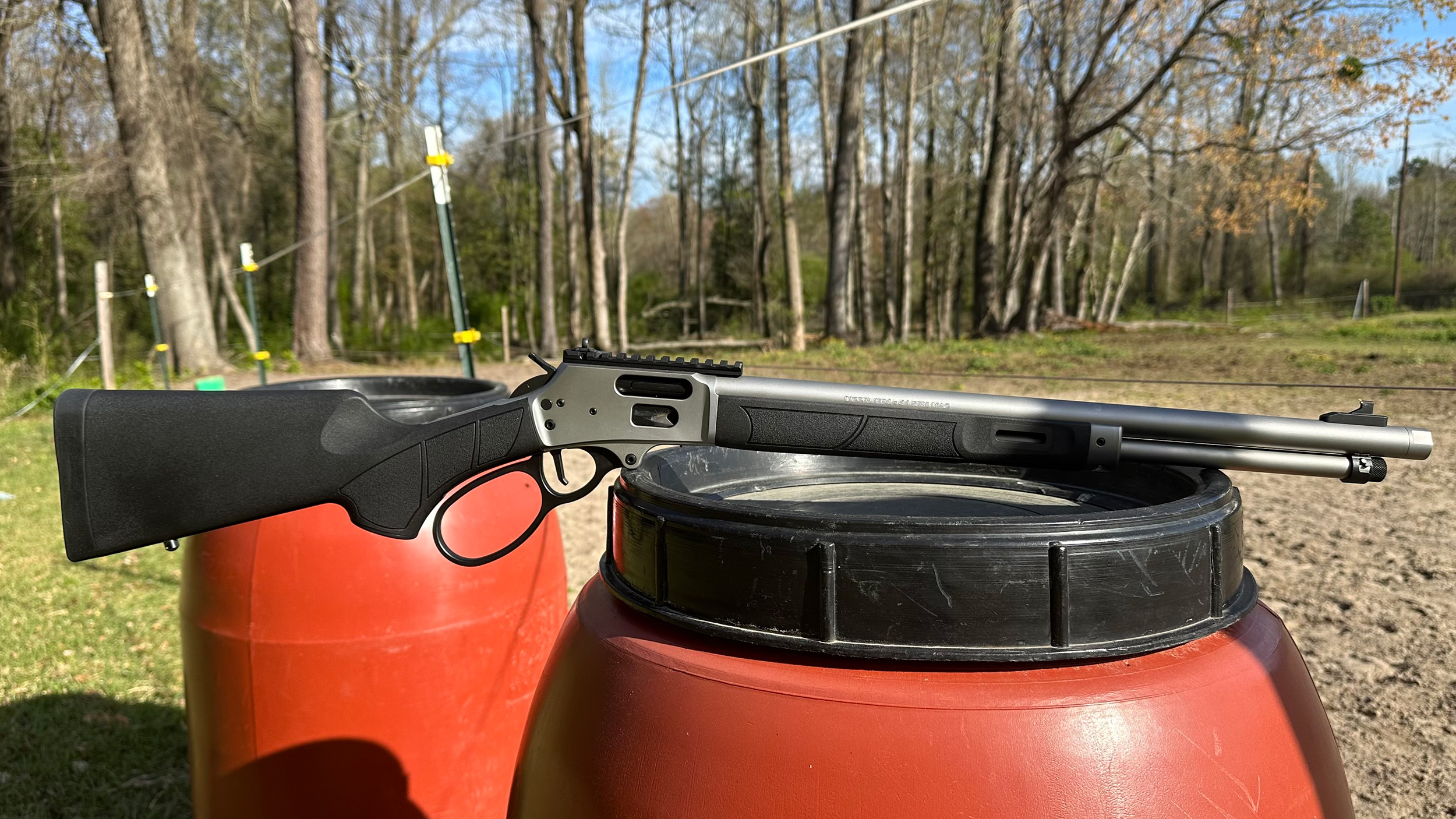
We may earn revenue from product links on this page and participate in affiliate programs. Learn More ›
Welcome to the beginning of the year of lever action rifles. If you aren’t familiar, the Smith and Wesson Model 1854 was announced at Shot Show 2024 along with 2-3 other companies’ lever action rifles.
It will be an exciting year for lever action rifles, and I couldn’t be more excited because I’ve wanted a good cowboy caliber lever action rifle since I got the Henry Model X.
Lever action rifles have been a long-standing action for rifles, but innovation has been so focused on modern platforms like the AR-15 that it feels like they have been left behind.
It seems like 2024 might break that down a bit. Henry has been doing a great job with takes on modern lever action rifles, but the goliath Smith and Wesson is no longer sitting on the lever action sidelines.
The Model 1854 is packed with features, so let’s dive in and see if the available feature set justifies the price.
Since this is a brand new release, I expect the calibers to expand as time goes on, but from the launch, it comes in 44 Remington Magnum, also known as simply 44 Magnum or 44 Mag. They are all the same thing, just different ways to say it, so don’t be confused.
However, the 44 Rem Mag 1854 can also shoot 44 Special but S&W advises this can cause buildup at the front of the chamber due to the shorter cases and should be cleaned thoroughly.
I’m very excited about this gun because I’ve wanted a cowboy round lever action since I got my hands on the Henry Model X in 45-70 Government and my Winchester 30-30.
The Model 1854 comes with a cross-bolt safety, and while I’m certain the engendering on this is solid, it’s still a little weird having a hammer fall full power when the safety is on.
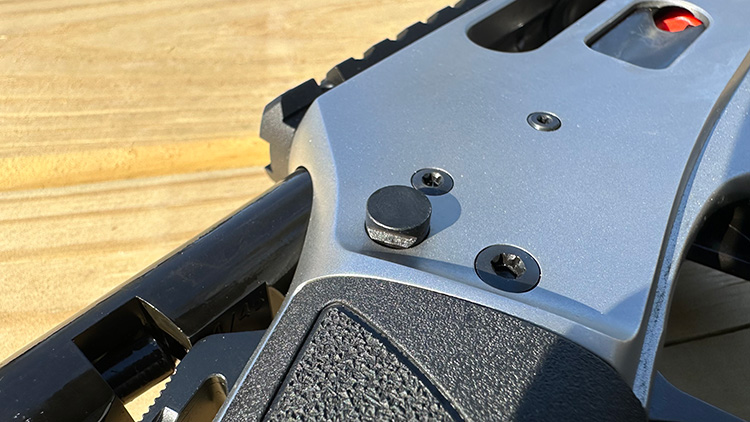
The trigger is still very much pull-able when the gun is on safety, which is important to know from the start.
Interestingly enough, Smith and Wesson recommend dry firing be done on the “no-fire” position, which most people would be called “on safe.”
I’m not saying this is a negative; it’s just an interesting tidbit to consider before picking the gun up and being surprised.
Smith and Wesson were smart to make this a loading gate lever action rifle because you can’t get your John Wayne on without a loading gate.
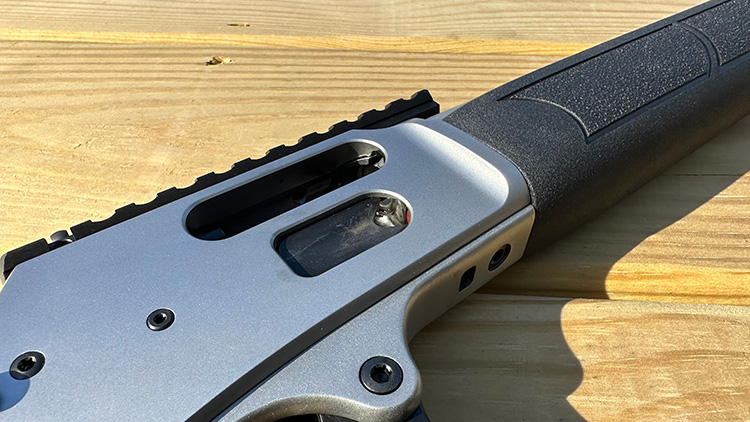
The loading gate is the true-to-form lever action feature and makes loading the gun enjoyable and gives you the lever gun experience you’re looking for.
It loads easily, and the loading gate door makes it easy for you to slide your rounds into the magazine tube.
The magazine tube holds nine rounds, giving the 1854 a 9+1 capacity. The magazine rod is released by pushing it in slightly and twisting it.
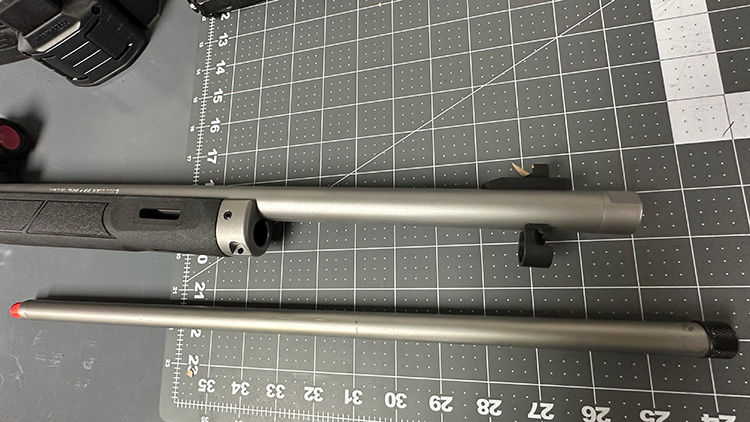
The entire magazine tube is removed from the gun and would allow you to pour out any ammo still in the gun.
You probably won’t be loading from this magazine tube, as it is completely removed and differs from other lever-action rifle magazine tubes.
One drawback of threaded lever-action rifles is that the magazine tube isn’t removable once you thread on a silencer.
The 1854’s furniture is synthetic, and while there is a limited edition one with wood furniture, it’s pretty expensive.
M-Lok is built into the handgrip at the end and has three positions: 3 o’clock, 6 o’clock, and 9 o’clock.
It features the same texture and patterning as S&W’s other M&P series guns.
Flat triggers are the best. I’m sorry if you hate them, but there’s no need for a trigger to be curved.
The take-up is minimal and the break is fantastic. I really like the trigger pull weight and the design and feel of the trigger.
If you have to have a curved trigger, unfortunately, this one won’t be for you.
Like the handguard, the stock is synthetic and has a fixed length of pull with a padded butt pad.
The stock’s grip also has texturing near the lever and trigger where you grip the gun.
It appears you can change the butt pad, but I don’t know if there are any aftermarket options for it yet or how to change it.
The quality of the plastic is good, and so far, it has been scratch resistant.
Levers make or break a lever action rifle because it’s the main control you must use to make the gun function.
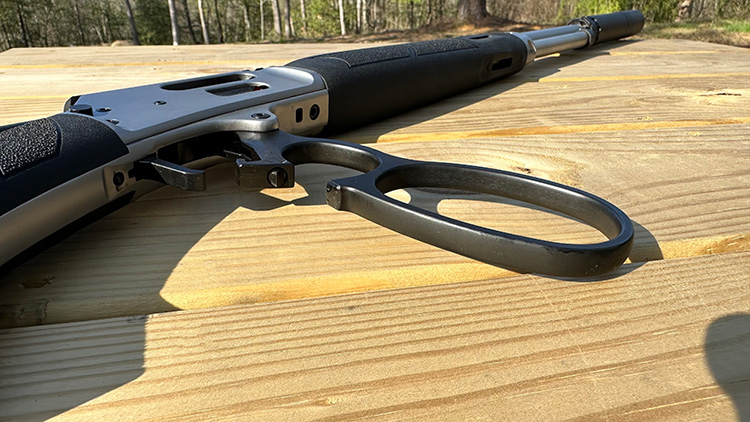
This lever has no slack, and there is no slop in the lever itself. It isn’t a large loop, but I think it is the right size—not too small and not too large, where it becomes cumbersome.
I would call this a mid-size lever that works perfectly on this gun.
The included rail is very convenient and includes the rear iron sight. The rear sight is a fixed sight but is built into the rail and has very simple windage and elevation screws that allow you to adjust the sight easily.
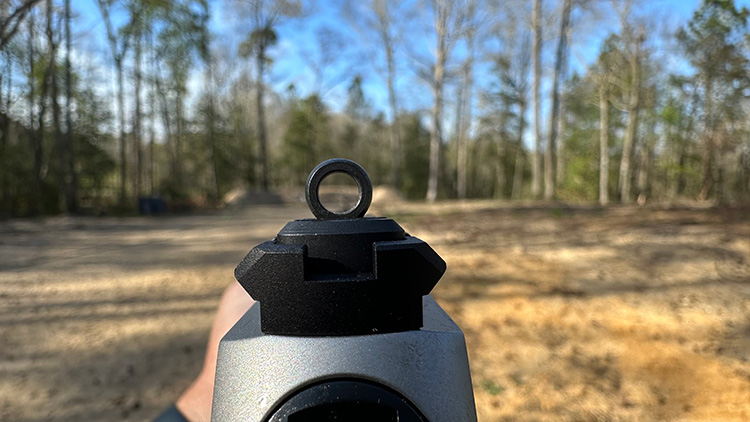
The elevation is adjusted by loosening the screw on one side of the sight. The sight can be turned to increase or decrease the elevation adjustment.
The rail mount can be removed and is compatible with Marlin 1894 hole pattern mounts and rails.
To this day, I still get pure t-hell from the YouTube comment section on my BL-22 review for wishing it had a threaded barrel.
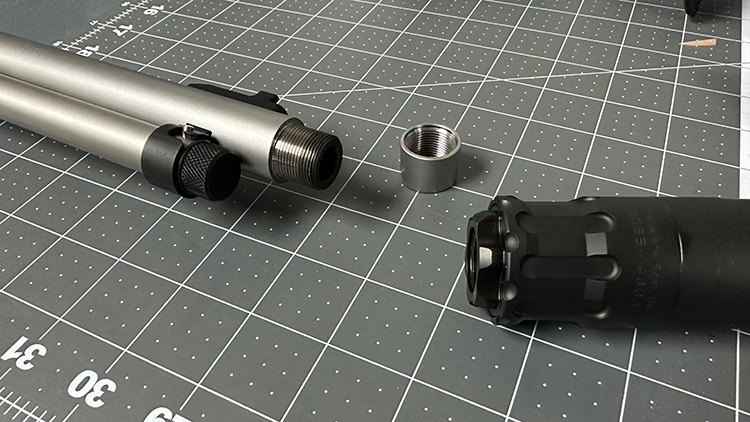
I love shooting suppressed. Everything but the dirtier gun is awesome and worth the hassle.
The fact that the 1854 comes with a threaded barrel is fantastic, but it’s not all rainbows and sunshine with threaded barrels.
Threaded barrels come in all different flavors but the technical term is thread pitch.
You’ll often see it listed in the product description and it usually looks something like this:
Well, in the case of this new 1854, the thread pitch is 11/16×24, and you might be wondering, is that good?
Well, it’s not good, and it’s not bad; it is what it is. This thread pitch isn’t common when considering 5.56, 9mm, and 300 Blackout/308 thread pitches.
The good news for those who don’t plan to suppress is that it comes with a thread protector, and if you never take it off, that’s okay.
I’ll dive more into what suppressors and combinations are available in the accessories section.
But, in my opinion, the threaded barrel is a killer feature.
I don’t think I’ve been this excited to shoot a rifle in a while, but what caught me off guard was the amount of recoil the 44 Rem Magnum round produced.
While it wasn’t bad it did catch me off guard but once I got the first round down it was on.
I had so much fun shooting this gun, and surprisingly, using the lever and getting back on target was rather easy and fluid.
Now for the main event! After all, you didn’t buy a Model 1854 not to suppress this bad boy!
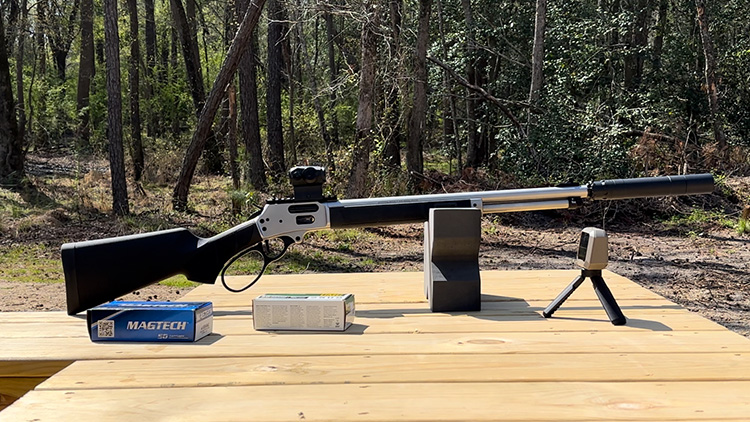
I went with the Rugged Obsidian 45 can and it worked great. Threading on was extremely easy and the noise reduction was substantial.
There is no gas back like you get with semi-auto rifle, which is to be expected because the chamber remains closed until you open it to eject the round.
The sould is still loud considering these rounds were travelling just over 2,200 FPS on average which is nearly double the speed of sound.
I highly recommend the Obsidian 45 can for the 1854 if you are in the market for a silencer for this gun.
No matter what gun you want to accessorize, the 1854 is no different. With the mentioned features, Smith and Wesson have made accessing a lever action rifle easier.
First, you’ll need to identify a can that is 44 Mag rated (or rather for whatever caliber your Model 1854 is).
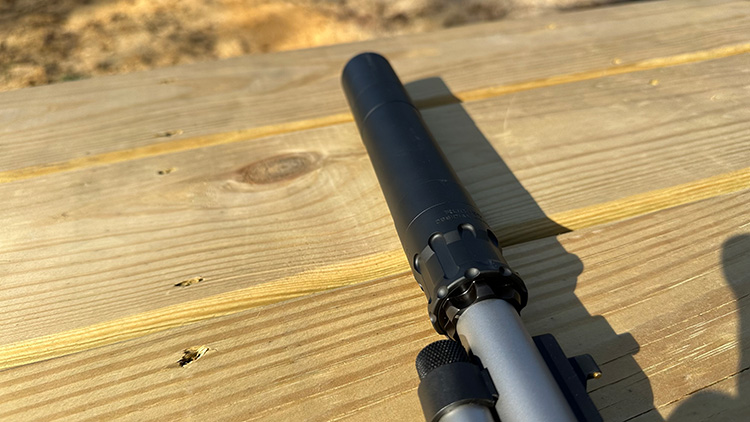
The rating is critical because the round must pass through the suppressor, and the suppressor must withstand the pressures the round creates.
So, ensuring the suppressor is rated for the round you plan to shoot is key.
Next, you’ll want to find a fixed barrel spacer and a piston that’s 11/16×24 or a direct mount that is 11/16×24 and removes the piston altogether.
My setup is the Rugged Obsidian 45 with the Rugged Fixed Mounts – 11/16×24.
Generally, most 45 ACP-rated silencers will work for 44 Mag the bullet diameter is smaller than the 45 ACP round. However, the pressure that the 44 Mag creates is typically much greater than the 45 ACP round.
Some other viable setups include:
One issue with lever-action rifle silencers is that the thread pitch isn’t as common. You want to ensure that whatever suppressor you use has the correct direct thread or piston attachment thread pitch.
You could mount small picitanny sections to the M-Lok sections of the rail if you had a 1913 attachment that you want to add.
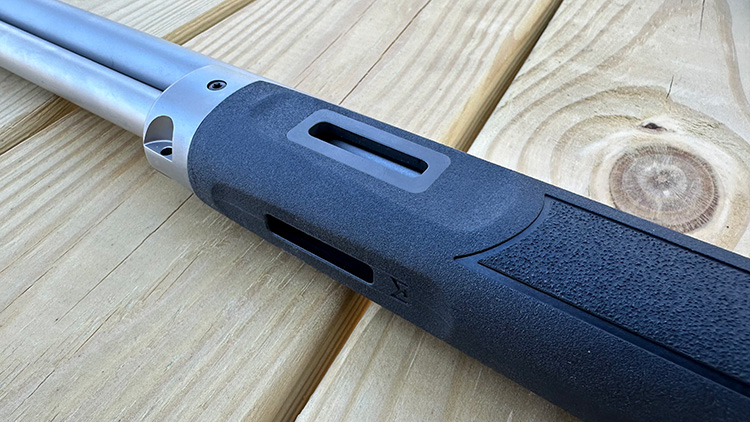
I probably won’t use them, but if you wanted to mount a flashlight or laser to the gun, it could be achieved using the M-lok slots and a rail attachment.
Optics can be tricky, but it depends on what you want to do with the gun. With it being a 44 Mag, I know I don’t need much or no magnification.
I opted for the rounded red dot sight, and while many will work, I preferred its aesthetic.
Something as simple as the Sig Romeo 5 is the direction I went on this rifle and so far it’s been fun!
I can see some medium LPVO style magnification would also be fun on this gun if you wanted to stretch it out and also get a clearer sight picture.
I have shot both the MAGTECH 240 grain and the Remington 180 grain, which both came in at around 2,200 FPS.
Both rounds had a consistent FPS and were accurate to the 75 yards I was shooting.
I highly recommend either of those two rounds, but I will also shoot some Sellier & Bellot rounds I’ll report back on.
If you love lever guns, you’ll love S&W’s take on this gun. This is a great place to start if you are on the fence about lever guns and want to dip your toes into the water.
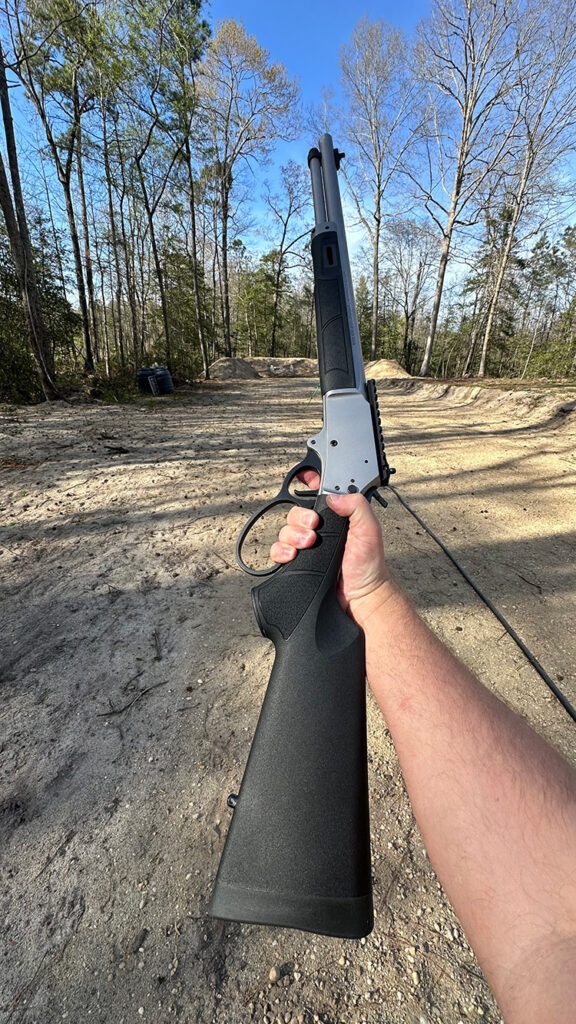
The gun gives you a lot of room to expand by adding optics, suppressors, and other accessories.
After my experience with the 1854 I have to give it a solid buy recommendation.
Concealed Carry Insurance
Protect yourself and all those who carry concealed in your house.